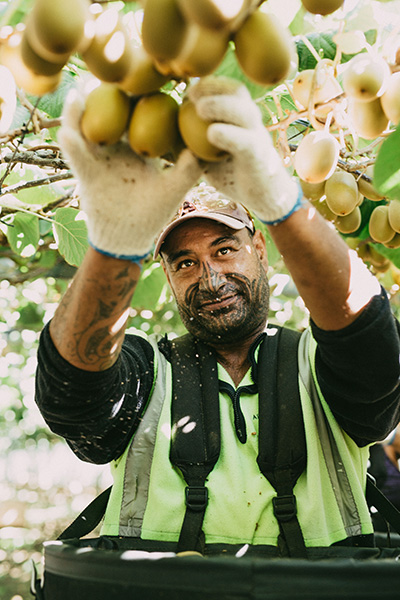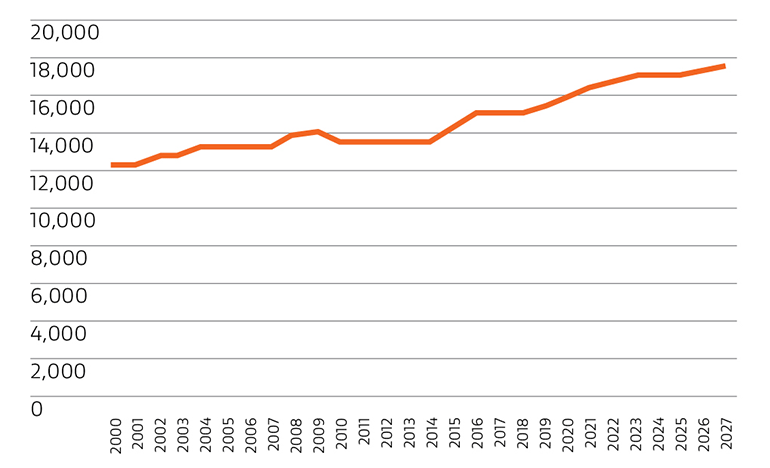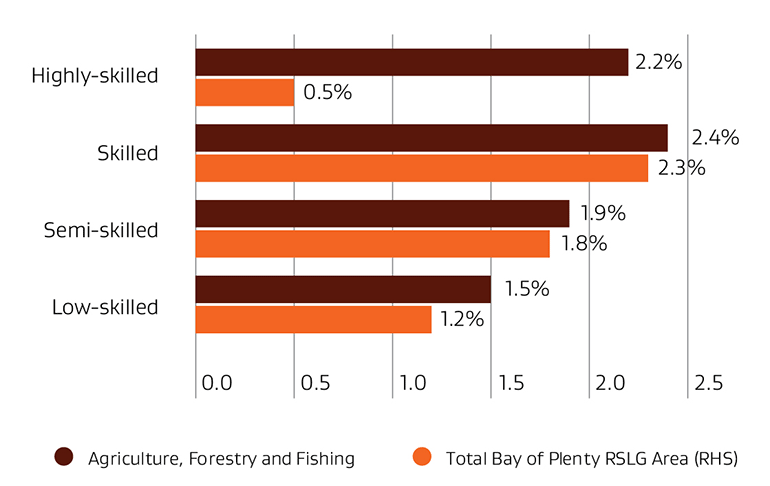Seasonality
On this page

The Bay of Plenty has a number of sectors and employers that are affected by seasonal market forces (across Horticulture, Forestry, Tourism and Aquaculture etc). By identifying peaks and troughs and collaborating across sectors we hope to promote greater access to a range of flexible, secure, and stable opportunities that individuals/whānau can tailor to suit their needs. Due to the contract/piece nature of work – there is the potential for risk to worker conditions and an accompanying aim will be to support sectors/employers mitigate this risk and combat work exploitation.
Our approach
The Bay of Plenty interim Regional Skills Leadership Group looked at the horticulture and forestry sectors and identified several workforce challenges and opportunities across both broad sectors relating to the industry’s seasonal nature.[11] When considering focus areas for this workforce plan, the Group members agreed more detailed analysis was required to better understand seasonal workforce patterns across multiple sectors and the entire Bay of Plenty area.
The Group has looked at the key sectors in the Bay that offer seasonal work, the types of work offered, who is most likely to fill these jobs, and what are some of the barriers that may restrict workers from transitioning into permanent, year-round work.
Alongside primary industries (Horticulture, Agriculture, Aquaculture and Forestry) the Group extended the scope to include tourism.
Key insights
The kiwifruit industry is the largest employer group across the Bay of Plenty Horticulture sector, with well documented challenges in securing seasonal workers. Existing programmes such as RSE (Recognised Seasonal Employee) scheme go some way to supporting the harvesting and packing worker shortages. Whilst the industry is investing heavily in automation, particularly in the post-harvest sector, there will still be a high labour need, particularly on-orchard over the medium term. The RSE programme has been noted as a ‘necessity’ for the Horticulture/Viticulture sector, and the reliance on this scheme is expected to remain.
RSE workers: a necessity for RSE employers. While the emphasis of the New Zealand stream was on impacts for communities, other findings have emerged. One of these is confirmation of the importance of RSE workers for the Horticulture and Viticulture industries. Although they are a relatively small component of the total seasonal workforce, RSE workers have become a necessity (not just a preferred source of labour). The Horticulture and Viticulture industries are increasingly reliant on skilled RSE labour for their ongoing expansion and ambitious export growth targets. Such expansion is fuelling greater reliance on RSE labour.[12]
Based on the predicted sector investment, NZKGI predict the kiwifruit seasonal workforce will grow from 19,500 in 2019 to 28,397 in 2031.[13]
BOP region employment for agriculture, forestry and fishing

Image description
The Forestry sector also operates in a seasonal structure. However, sector representatives shared examples of how year-round work can be provided if workers are willing and suitably skilled to transition between different functions in the industry (e.g., from silviculture to harvest).
Filled jobs

Graph description
In terms of Agriculture, dairy farming and arable cropping also present seasonal workforce peaks and troughs. Like Forestry, many employers can offer year-round and permanent employment to workers who are willing and suitably skilled to transition to work on different aspects of the farm production cycle.
Aquaculture is a growth sector for the Bay of Plenty, with sizeable private, iwi and public sector investments accelerating workforce growth in the Eastern Bay of Plenty region.
As well as the new $37 million Whakatōhea mussel processing facility (expected to create 230 jobs in Ōpōtiki by 2025[14]), there are additional ancillary developments like the Ōpōtiki Harbour development[15] and the Te Kaha Mussel Spat hatchery[16] that will require a suitably skilled workforce. These combined Aquaculture investments in Eastern Bay of Plenty will create up to 1,000 new jobs in a relatively small regional community.
The Tourism sector has been severely impacted by COVID-19 in recent years, but prior to the pandemic both the Rotorua and Taupō districts had more than 30% of their respective workforce employed in direct or indirect tourism roles. The severe drop in visitation has seen high numbers of these workers transition into new roles and industries, and for this reason the sector may not be able to recruit the necessary workers required to operate once the country’s borders fully reopen. The Tourism sector will need to swiftly rebuild its workforce; however, it is not yet widely understood what the job shortage impact will be for Bay of Plenty.
Across all sectors considered, there were several shared issues for both workers and employers:
- Labour mobility – the workers aren’t always where the work is, and vice versa. This problem is confounded by lower levels of driver-licencing in sub-regional areas of Bay of Plenty.
- Some employers reported challenges in supporting new workers to source their Proof of Identity.
- Some employers reported ongoing challenges with having casual and seasonal workers pass necessary health and safety protocols including pre-hire and on-the-job drug and alcohol testing.
- Workers aren’t normally directly employed by orchardists in the Horticulture sector. As such, the day rates of pay and volume-based pay systems used may see workers not receiving minimum wage for their work.
- Current employment law provisions don’t fully recognise the nuances of seasonal work, and for this reason while an individual may be ‘fully’ employed by moving across multiple employers over a 12-month period in response to seasonal work opportunities, they do not receive the same employment law protections (e.g sick leave) as permanent employees.
Case study: COVID-19 Response – Kiwifruit Industry Labour Co-Ordination Centre
In 2020, the COVID-19 crisis struck and within a short time New Zealand was in lockdown. The kiwifruit industry was massively affected by this with the number of backpackers and RSE workers, which make up around 50% of the workforce, becoming limited.
Fortunately, the kiwifruit industry was able to offer work to people within New Zealand whose jobs were impacted by the lockdown in areas including Hospitality, Forestry and Tourism (such as staff from the Matamata Hobbiton tourist attraction) in kiwifruit orchards and packhouses.
To facilitate this, NZKGI collaborated with Zespri to form a Labour Coordination Centre (LCC) to match prospective employees with employers.
At its peak the LCC communicated with 1,000 people and directed them to 550 vacancies. While there were some challenges experienced, including high turnover rates, these efforts largely mitigated a serious shortfall in labour allowing the successful harvest of kiwifruit and provided employment for a large number of locals out of work due to COVID 19.
This industry has been recognised for coming together in times of trouble, and during COVID-19 collaboration and co-operation between growers, contractors and the post-harvest sector meant sharing what worked. Everyone understood that we would get there by working together.
NZKGI Labour Coordinator Gavin Stagg.
Seasonality action statements
- Define BOP cross-sector seasonality workforce patterns [Horticulture, Forestry, Aquaculture, Tourism, Agriculture] for the full region to better inform future planning.
- Support sector groups/industry clusters/large employers to develop their own bespoke micro-credential/on-the-job training programmes.
- Support employers to deliver richer employment and learning experiences.
- Identify services and programmes that can reduce the barriers to people entering seasonal work.*
- Explore the impacts of automation, robotics, and AI for the future workforce, and identify skills required to transition into these roles of the future.*
* Not exclusive to this aspiration, will be cross-cutting theme of RWP
Footnotes
[11] | Bay of Plenty interim Regional Skills Leadership Group summary report [PDF, 3.4 MB]
[12] | RSE impact study: New Zealand stream report(external link) — New Zealand Immigration
[13] | NZKGI Labour Report for the 2020 Season [PDF, 1.3MB](external link) — New Zealand Kiwifruit Growers
[14] | Whakatōhea Mussels’ $37m mussel processing factory officially opened(external link) — Bay of Plenty Times
[15] | Te Ara Moana Toi – a path to the sea: Opotiki Harbour update September 2019 [PDF, 4.5MB](external link) — Opotiki District Council
[16] | Te Whānau ā Apanui granted $6m for land-based mussel spat hatchery(external link) — Te Ao Māori News

